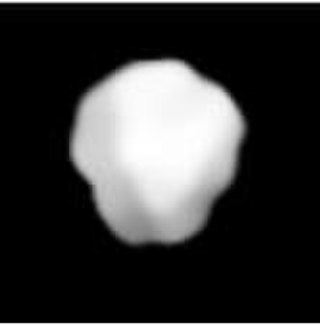Top Qs
Timeline
Chat
Perspective
11 Parthenope
Large main-belt asteroid From Wikipedia, the free encyclopedia
Remove ads
11 Parthenope (/pɑːrˈθɛnəpi/ parth-EN-ə-pee) is a large, bright asteroid located in the main asteroid belt.
Remove ads
History
Parthenope was discovered by Annibale de Gasparis on 11 May 1850, the second of his nine asteroid discoveries. It was named after Parthenopē, one of the Sirens in Greek mythology, said to have founded the city of Naples. De Gasparis "used his utmost endeavours to realise a 'Parthenope' in the heavens, such being the name suggested by Sir John Herschel on the occasion of the discovery of Hygiea in 1849".[7] Two symbols were proposed for Parthenope: a fish and a star (encoded in Unicode 17.0 as U+1CEC4 ![]() ) while such symbols were still in use, and later a lyre (encoded in Unicode 17.0 as U+1F77A
) while such symbols were still in use, and later a lyre (encoded in Unicode 17.0 as U+1F77A ![]() ) in lists of symbols. Both are obsolete.[8][9][10]
) in lists of symbols. Both are obsolete.[8][9][10]
In 1988 a search for satellites or dust orbiting this asteroid was performed using the UH88 telescope at the Mauna Kea Observatories, but the effort came up empty.[11]
Remove ads
Orbit

Parthenope orbits the Sun at an average distance (its semi-major axis) of 2.454 astronomical units (AU), with an orbital period of 3.845 years. Its distance from the Sun varies from 2.209 AU at its perihelion to 2.699 AU at its aphelion, indicated by its orbital eccentricity of 0.0998. Its orbit is inclined by 4.633° with respect to the ecliptic plane.[3]
Remove ads
Physical Characteristics
In 2007, Baer and Chesley calculated a higher mass and density for Parthenope based on perturbations by the 90 km asteroid 17 Thetis. Baer and Chesley calculated a mass of 6.3×1018 kg with a density of 3.3 g/cm3.[12] 2008 estimates by Baer suggest a mass of 6.15×1018 kg.[5] The 1997 and 2001 estimates by Viateau and Rapaport were closer to 5×1018 kg with a density of 2.7 g/cm3.[12]
Based upon a light curve that was generated from photometric observations of Parthenope at Pulkovo Observatory, it has a rotation period of 13.722 ± 0.001 hours and varies in brightness by 0.10 ± 0.0s in magnitude. The light curve displays three maxima and minima per cycle.[13]
See also
Notes
References
External links
Wikiwand - on
Seamless Wikipedia browsing. On steroids.
Remove ads


